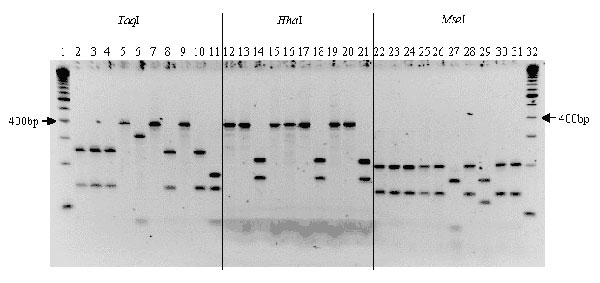Volume 6, Number 3—June 2000
Dispatch
Bartonella spp. Isolated from Wild and Domestic Ruminants in North America 1
Figure

Figure. Polymerase chain reaction/restriction fragment length polymorphism of the citrate synthase gene of isolates from cattle, deer, and elk, with TaqI, HhaI, and MseI endonucleases. Lanes 1 and 32, standard 100-bp molecular ladder; lanes 2, 12, and 22, cattle isolate; lanes 3 to 7, 13 to 17, and 23 to 27, deer isolates; lanes 8 to 10, 18 to 20, and 28 to 30, elk isolates; lanes 11, 21, and 31, B. henselae strain.
1An earlier version of this paper was presented at the Second International Conference on Emerging Zoonoses, Strasbourg, France, November 5-9, 1998.
2Collection sites were for bighorn sheep, the Peninsular Ranges in California and the San Francisco River, Turkey Creek, and Red Rock in New Mexico; and for elk, the San Luis National Wildlife Refuge in Merced County and the Tupman Tule Elk State Reserve in Kern County, California, and the Roseburg, Drain, and Demet herds, Douglas County (south western Oregon), and the Jewell Wildlife Area, Clatsop County, (north western Oregon).